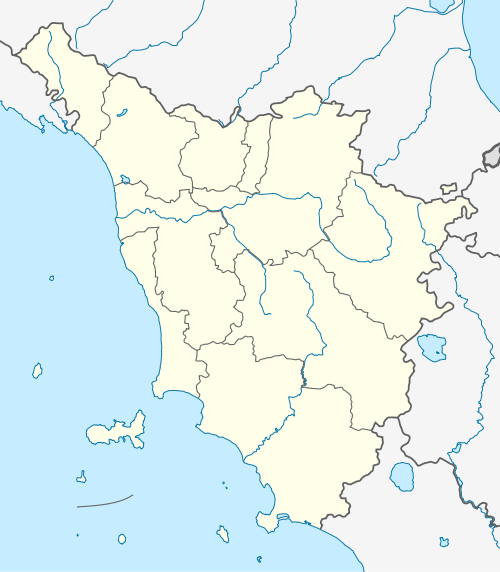Grosseto railway station
Grosseto | |
|---|---|
|
View of the passenger building. | |
| Location |
Piazza Guglielmo Marconi 58100 Grosseto GR Grosseto, Grosseto, Tuscany Italy |
| Coordinates | 42°46′03″N 11°06′24″E / 42.76750°N 11.10667°ECoordinates: 42°46′03″N 11°06′24″E / 42.76750°N 11.10667°E |
| Operated by |
Rete Ferroviaria Italiana Centostazioni |
| Line(s) |
Pisa–Livorno–Rome Siena–Grosseto |
| Distance |
187.644 km (116.597 mi) from Roma Termini |
| Train operators | Trenitalia |
| Connections |
|
| Other information | |
| Classification | Gold |
| History | |
| Opened | 15 June 1864 |
| Location | |
 Grosseto Location within Tuscany | |
Grosseto railway station (Italian: Stazione di Grosseto) is the main station serving the city and comune of Grosseto, in the region of Tuscany, central Italy. Opened in 1864, it forms part of the Pisa–Livorno–Rome railway.
The station is currently managed by Rete Ferroviaria Italiana (RFI). However, the commercial area of the passenger building is managed by Centostazioni. Train services to and from the station are operated by Trenitalia. Each of these companies is a subsidiary of Ferrovie dello Stato (FS), Italy's state-owned rail company.
The Pisa–Livorno–Rome railway is a double track main line connecting Pisa with the Tyrrhenian Sea and Rome. Grosseto railway station is roughly at its half way point. The station is also one of the termini of a single-track non-electrified secondary line to Siena. That line continues on from Siena as the Central Tuscany railway, and later as the Leopolda railway, towards Empoli and Florence.
Location
Grosseto railway station is situated in Piazza Guglielmo Marconi, near the centre of the city, just north of the old town.
Piazza Marconi, often erroneously referred to as Station Square, is known for its statue of a buttero (1953) by sculptor Tolomeo Faccendi.
History
The station was opened on 15 June 1864, upon the opening of the Follonica–Grosseto and Grosseto–Orbetello sections of the Pisa–Livorno–Rome railway.[1]
Features
The station complex extends laterally along the western side of the Piazza. The passenger building was built in the rationalist style of the first half of the twentieth century. It is made up of several buildings huddled together, on two levels.
At the ground floor level, the passenger building's central facade is characterized by five portals with architraves topped by round arches. These are protected by a canopy protruding from the crease that separates the two levels of the building. At each side of the central facade are open rectangular portals. One of them leads to the bar, and the other to the waiting room.
Extending across the mezzanine level of the passenger building is a series of rectangular windows, while in the central part of the main facade at that level is a square station clock, which forms a crowning feature.
The station yard has five tracks with platforms for the boarding and alighting of passengers. There is also a large goods yard.
Passenger and train movements
The station has about 1.5 million passenger movements each year.[2]
Trains stopping at the station include Eurostar City Italia trains, all InterCity trains to Torino Porta Nuova, Milano Centrale, Ventimiglia, Savona, Roma Termini, Napoli Centrale, Salerno, some express trains to southern Italy and Sicily and all the regional trains operating on the Tyrrhenian line and the secondary line to Siena.
Eurostar Fast trains passing through the station do not stop there.
Along the line connecting Grosseto with Siena, just north of Monte Antico railway station, is a junction, with a secondary line direct to Buonconvento used by passenger and goods trains, and another line direct to San Giovanni d'Asso and Asciano. The latter line is used only by railcars and multiple units stopping at various stations, from which excursions can be taken to nearby medieval villages and castles. Just before Siena, the two secondary lines converge once again to continue along a common path.
Interchange
The station is the terminus of many urban and suburban bus lines operated by Rama, the transport company serving the whole province of Grosseto.
See also
- History of rail transport in Italy
- List of railway stations in Tuscany
- Rail transport in Italy
- Railway stations in Italy
References
Notes
- ↑ Alessandro Tuzza; et al. "Prospetto cronologico dei tratti di ferrovia aperti all'esercizio dal 1839 al 31 dicembre 1926" [Chronological overview of the features of the railways opened between 1839 and 31 December 1926]. Trenidicarta.it (in Italian). Alessandro Tuzza. Retrieved 26 November 2010. External link in
|work=(help) - ↑ "Flussi Annui nelle 103 Stazioni" [Annual flows at the 103 stations]. Centostazioni website (in Italian). Centostazioni. Retrieved 4 December 2010.
Further reading
- Parisi, Marcella, ed. (2001). Grosseto dentro e fuori porta. L'emozione e il pensiero [Grosseto indoors and outdoors. The emotion and thought] (in Italian). Siena: C&P Adver Effigi (Associazione Archeologica Maremmana).
External links
![]() Media related to Grosseto railway station at Wikimedia Commons
Media related to Grosseto railway station at Wikimedia Commons
This article is based upon a translation of the Italian language version as at December 2010.